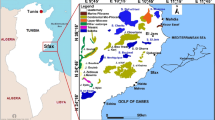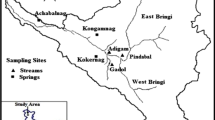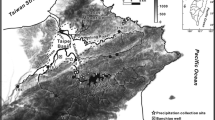Abstract
Over a 1-year period, 343 samples, including precipitation, creek, pond, and groundwater, were collected from June 2003 to May 2004. Analyses were performed for stable oxygen and hydrogen isotope compositions. Selected samples were also analyzed for tritium. The goal was to identify possible hydrologic factors contributing to a severe landslide in the Li-Shan area, central Taiwan. The isotope characteristics indicate that groundwater from Fu-Shou-Shan farm located up-slope from the landslide area is a major source for slope groundwater, in addition to precipitation. The groundwater is mainly recharged by pond water at Fu-Shou-Shan farm. According to the calculation of a two-end member equation with δ 18O, the contribution of farm groundwater to slope groundwater is significantly higher than that of precipitation, up to a factor of five. The estimated drainage efficiency of the existing system is only 23%. Draining off the slope groundwater in the up-slope region to decrease farm groundwater flow into the slope area is a feasible strategy to effectively reduce the risk of landslide.







Similar content being viewed by others
References
Allison GB, Hughes MW (1977) The history of tritium fallout in Southern Australia as inferred from rainfall and wine samples. Earth Planet Sci Lett 36:334–340
Clark ID, Fritz P (1997) Tracing the hydrological cycle. In: Environmental isotopes in hydrogeology. CRC Press, Florida, pp 35–60
Coleman ML, Shepherd TJ, Durham JJ, Rouse JE, Moore GR (1982) Reduction of water with zinc forhydrogen isotope analysis. Anal Chem 54(6):993–995
Craig H (1961) Isotopic variations in meteoric waters. Science 133:1702–1703
Criss RE (1999) Isotope hydrology. In: Principles of stable isotope distribution. Oxford University Press, New York, pp 89–136
Dadson SJ, Hovious N, Chen H, Dade BW, Willett SD, Hu JC, Horng MJ, Chen MC, Stark CP, Lague D, Lin JC (2003) Links between erosion, runoff variability, and seismicity in the Taiwan orogen. Nature 426:648–651
Dansgaard W (1964) Stable isotopes in precipitation. Tellus 16:436–468
Epstein S, Mayeda T (1953) Variation of O-18 content of waters from natural sources. Geochim Cosmochim Acta 4:213–224
Energy and Resources Laboratories (ERL) (1993) The plan of investigation and remediation for rock slide in Lishan area. Soil and Water Conservation Bureau, Taichung [in Chinese]
Fritz P (1981) River waters. In: Gat JR, Gonfiantini R (eds) Stable isotope hydrology: deuterium and oxygen-18 in the water cycle. IAEA Technical Reports Series No. 210, pp 177–202
IAEA (1983) Guidebook on nuclear techniques in hydrology. IAEA Technical Reports Series No. 91, IAEA, Vienna
Ingraham NL (1998) Isotopic variation in precipitation. In: Kendall C, McDonnell JJ (eds) Isotope tracers in catchment hydrology. Elsevier, Amsterdam, pp 87–118
Kaufman S, Libby WF (1954) The natural distribution of tritium. Phys Rev 93:1337–1344
Lai TC (2000) The role of geological investigation in the planning or design a landslide stabilizing measurement—case study of Lishan landslide stabilization. In: Paper presented at proceedings of the second national conference on landslide stabilization and disaster prevention in Taiwan, 16–18 February 2000 [in Chinese with English abstract]
Lee KS, Wenner DB, Lee I (1999) Using H- and O-isotopic data for estimating the relative contributions of rainy and dry season precipitation to groundwater: example from Cheju Island, Korea. J Hydrol 222:65–74
Lin CC (1957) Geomorphology of Taiwan. Taiwan Province Archives, Taipei [in Chinese]
Liu KK (1984) Hydrogen and oxygen isotopic compositions of meteoric waters from the Tatun Shan area, northern Taiwan. Bull Inst Earth Sci, Acad Sin 4:159–175
McCarthy KA, McFarland WD, Wilkinson JM, White LD (1992) The dynamic relationship between ground water and the Columbia river: using deuterium and oxygen-18 as tracers. J Hydrol 135:1–12
Ministry of Economic Affairs (MOEA) (1975) An introduction to the geology of Taiwan. The Ministry of Economic Affairs, Taipei
Ministry of Economic Affairs (MOEA) (1982) Tectonic evolution of Taiwan. The Ministry of Economic Affairs, Taipei
Peng TR, Wang CH, Liu TS (2002) Hydrogen and oxygen isotope variation in I-Lan precipitation. Taiwan J Agric Chem Food Sci 40(5):336–346 [in Chinese with English abstract]
Rozanski K, Araguás-Araguás L, Gonfiantini R (1993) Isotopic patterns in modern global precipitation. In: Swart PK, Lohmann KC, McKenzie J, Savin S (eds) Climate change in continental isotopic records. Geophysical Monograph 78, American Geophysical Union, pp 1–36
Tsai YB (1986) Seismotectonics of Taiwan. Teconophysics 125:17–37
Unterweger MP, Coursey BM, Shima FJ, Mann WB (1980) Preparation and calibration of the 1978 National Bureau of Standards tritiated water standards. Int J Appl Radiat Isot 31:611–614
Wang CH, Peng TR (2001) Hydrogen and oxygen isotopic compositions of Taipei precipitation: 1990–1998. Western Pacific Earth Sci 1(4):429–442
Water Resources Agency (WRA) (2003) Hydrological year book of Taiwan, Republic of China. Ministry of Economic Affairs, Taipei
West TR (1995) Landslides, subsidence, and slope stability. In: Geology applied to engineering. Prentice Hall, NJ, pp 281–319
Yurtsever Y, Gat JR (1981) Atmospheric waters. In: Gat JR, Gonfiantini R (eds) Stable isotope hydrology: deuterium and oxygen-18 in the water cycle. IAEA Technical Reports Series No. 210, pp 103–142
Acknowledgments
The authors are grateful to reviewers for their constructive comments in improving the paper. We also thank laboratory assistants in collecting and analyzing samples through the study period. This work is financially supported by funds from National Science Council, Academia Sinica and Council of Agriculture of Taiwan.
Author information
Authors and Affiliations
Corresponding author
Rights and permissions
About this article
Cite this article
Peng, TR., Wang, CH., Lai, TC. et al. Using hydrogen, oxygen, and tritium isotopes to identify the hydrological factors contributing to landslides in a mountainous area, central Taiwan. Environ Geol 52, 1617–1629 (2007). https://doi.org/10.1007/s00254-006-0607-4
Received:
Accepted:
Published:
Issue Date:
DOI: https://doi.org/10.1007/s00254-006-0607-4




